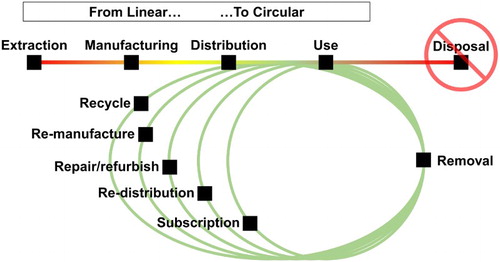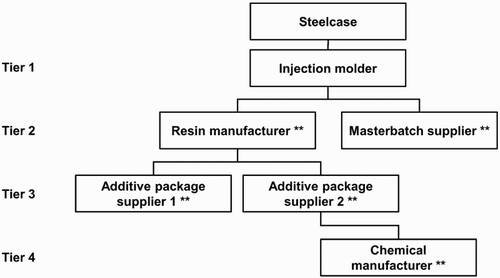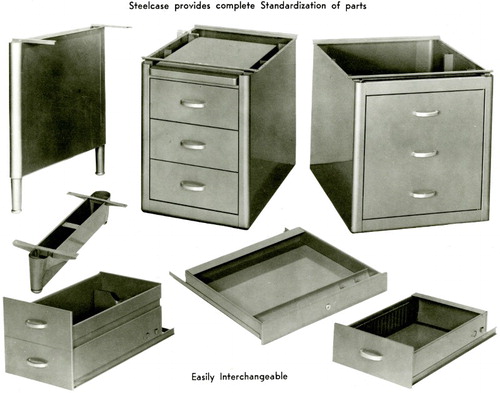ABSTRACT
Nearly every industry faces the same question, whether they realize it yet or not: how do we reinvent our businesses to ensure resilience and prosperity today and into the future? The current linear economy is fraught with waste, inefficiencies, and toxic chemicals that cost businesses, consumers, and society. Since its inception more than 100 years ago, Steelcase has been on a path toward circularity. It began with operational excellence and product innovation. For the last decade, the company has been focusing on transformation through circular business models. This work involves product-service business models, new ways to engage with our customers, and a new lens to think about products. Green chemistry is a foundational component to delivering on this strategy and one we will explore in this article.
GRAPHICAL ABSTRACT

1. Introduction
Several significant challenges are faced by manufacturers today. Businesses face price volatility in materials and energy, risk of material depletion, increasing demands related to end of life, climate change, and a rapidly changing marketplace. It is clear that “business as usual” is no longer a viable option. It is also true that the current linear economy is reaching the end of its relevance. While the circular economy is not a new idea in many respects, the concepts and potential for growth continue to resonate with business leaders.
One early example from Steelcase’s (then Metal Office Furniture Co.) path to a more sustainable, circular business model can be found in the desking and storage products advertising from 1945. Steelcase recognized that users desired the ability to reconfigure and customize spaces, adjust as needed, and replace or repair broken parts when necessary (). One advertisement read, “Metal Office Furniture Co. is the first furniture maker with a complete standardization and interchangeability of parts, allowing for more than 200 different arrangements of desks and tables.”Footnote1
While this initiative certainly was not advertised as a circular economy advancement, it is clear today that this idea would fit well in the circular products space. Easy disassembly of products offers the opportunity for repair, replacement, or recycling as much as it offers users the opportunity to reconfigure the space as needed. These features afford the opportunity to keep products in use and viable for longer, and make them easier to handle responsibly when their usable life is over. If industry can leverage the insights of the past, apply current technologies and innovations, and think deeply about new business models, we will be able to create a circular economy that benefits industry, the public, and the environment.
1.1. Sustainability at Steelcase: toward a circular economy
Steelcase’s stated purpose as a company is to unlock human promise, a goal fundamentally linked to sustainability. We have been working toward operational excellence for decades. We were one of the first in our industry to make significant strides on product circularity through eco-design and lifecycle thinking, the deep materials chemistry work of collecting data and performing hazard assessments, and end of life strategies. While this work is important, product sustainability alone will not lead to a circular economy. This is why the company has been piloting, developing, and growing existing and new business models that will enable closure of the loops within the circular economy.
So, while the focus of this article will be on Steelcase’s work in green chemistry, it is important to keep the larger picture of the company’s circular economy strategy in mind as a backdrop for why green chemistry is important, but also why it cannot be the only strategy for a company (or industry) serious about making real change.
1.2. The role of green chemistry
After considering the role of sustainability in product design and business models, the next question to address is how can a manufacturer of architecture, furniture, and technology products incorporates green chemistry?
Steelcase takes a comprehensive approach to understanding what goes into our products and the impact on human and environmental health. We are both precautionary and proactive. Our process is about knowing, acting, and solving: (1) collecting deep chemistry information from our suppliers; (2) understanding the material through a chemical hazard assessment; and (3) finding an alternative of equal or greater performance.
2. Discussion
2.1. Knowing: collection of deep chemistry information from our suppliers
The first method by which we participate in green chemistry is by collecting detailed chemistry information from our supply chain. As a designer and manufacturer of complex, multi-component products, collection of this information is challenging, but offers opportunities for innovation. Due to the nature of our products and industry, we typically have limited visibility to the formulations of the materials we use. From adhesives to coatings, plastics to foams, we rely on our supply chain partners to disclose information about the chemistry in the materials we purchase.
Another challenge in this work also exists in our value chain proximity, or lack thereof, to the suppliers with access to formulation information – sometimes having to dive down more than five tiers into the supply chain. Let’s take an injection molded plastic part as an example (). In this case, Steelcase purchases the part from an injection molder. They purchase resin and colorant to match our specification from suppliers of their own, namely the resin manufacturer and the masterbatch formulator. Those suppliers, in turn, may be purchasing their starting materials from several different formulators and chemical manufacturers. In this case, we might end up collecting the chemical information from a supplier we have no direct purchasing relationship with the third or fourth tier of the chain. Furthering the complexity, chemistry information at the CAS number level will be found (in most cases) at several levels of the supply chain, requiring putting it all together and evaluating for completeness.
Figure 2. Data collection schematic for an injection molded part. **Represents places in the supply chain where specific CAS-level chemistry information may be collected in the process.

Lastly, many formulators consider their chemistry proprietary. Often, formulators will not disclose the chemistry of formulas or will only do so under restrictive confidentiality agreements. It is not all bad, though, as this process offers a unique window into the deeper parts of the supply chain that organizations not doing this work may not see. Having direct relationships with indirect suppliers because of the materials chemistry data collection process can lead to better collaboration through our supply chain, more efficient resolution of quality issues when they exist, and the possibility to optimize problematic chemistry in the supply chain.
2.2. Acting: understanding the material through chemistry assessment
Once we have detailed chemical information, the next step is to complete a hazard assessment. These comprehensive assessments, done either in house or through a third-party assessor, provide us with insight into where we can improve our materials to be safer for everyone along the value chain, including humans and the environment.
Steelcase uses a variety of different assessment methodologies depending on project goals, material type, material purchase volume, and likelihood of high hazard. Our primary assessment protocol is the Cradle to Cradle Certified™ Material Health Assessment Methodology.Footnote2 We have worked with McDonough Braungart Design Chemistry (MBDC) for more than a decade on this work and have thus far assessed approximately 1800 materials. The methodology considers both human and environmental hazard endpoints and results in a Green (low hazard), Yellow (moderate hazard), or Red (high hazard) score for each material where sufficient data exist. In cases where sufficient toxicological data on a chemical do not exist in the literature and cannot be adequately modelled, a “gray” assessment score results until further data become available. The Cradle to Cradle program also has a list of restricted chemicals. Where those chemicals exist in products, certification to the Cradle to Cradle program is not possible.
More recently, Steelcase has invested in GreenScreen® for Safer Chemicals training to allow for in-house material health assessments when multiple options are being considered for the same application.Footnote3 This program, very much aligned with the Cradle to Cradle methodology, provides a framework to assess chemicals against human and environmental toxicity endpoints and assign final “benchmark” scores of 1–4 (BM 1–4), with BM1 being the most hazardous and BM4 being the least.Footnote4
In other cases, Steelcase may use quick screening methods such as GreenScreen List Translator® and comparing chemicals against regulatory and market red lists.Footnote5 This menu of hazard assessment and screening methodologies allows for flexibility and agility depending on the changing needs of our marketplace and the various requirements of our certification programs.
2.3. Solving: finding alternatives of equal or greater performance
The next step in Steelcase’s green chemistry work involves exploring alternatives. When we find chemicals of concern in the materials we purchase, we have a few different options. These options include: (1) working with current suppliers to remove or replace the chemical; (2) finding an alternative material or supplier; or (3) re-designing the product to avoid the material altogether.
The first option is to work with our current supplier to remove or replace the chemical in the material. This is often our first course of action because it preserves the current design of a product and affords the optimization pathway with the lowest cost and minimal disruption to the business. This method also preserves the relationship with the current supplier and affords them the opportunity to innovate, something that is very important to Steelcase. One example of this type of work is the removal of flame retardants from polyurethane foam. Where it was possible to remove flame retardants and still meet flammability codes and regulations in the various regions we sell products, our foam producers removed flame retardants altogether without additional changes to the foam formulations.
The second option for exploring safer chemistry is finding an alternative material supplier that provides a similar material with a modified chemistry. One example where Steelcase invested in this type of material change was the replacement of PVC in edge banding for table and desking applications in favor of polypropylene edge bands. This work required investment with new suppliers, color matching, and testing, but resulted in an edge band solution that is more favorable from both a materials chemistry and eco-design point of view. Making material changes of this type is exciting, but it can be disruptive in the supply chain. It requires significant investment in product testing to ensure that it meets our company’s high safety and quality standards.
Another option for industry is to re-design product to avoid the chemical or material of concern altogether. This activity is best tackled during initial product development phases as opposed to once a product is on the market. It has the potential to open the door for a high level of innovation. It requires significant investment and collaboration from product development teams including engineers, designers, sustainability professionals, marketing professionals, and others. One theoretical example of this work is the re-design of a seat shell on a chair that allows a mechanical attachment of the foam cushion (e.g. snap fit) to remove an adhesive with chemicals of concern.
2.4. What’s next?
After all the collection, assessment, and exploration of alternative technologies, one might think the job is done. The step of making a change in a product, however, can be the most difficult. The manufacturing industry, in many ways, is wired to resist change. Making material changes involves many potential challenges and costs.
The removal or replacement of a chemical in an existing material can trigger the need for testing the physical properties, environmental stability, flame resistance, and comfort and market desirability.
Implementing a new, innovative material to replace an existing material of concern can require additional investments. In this case, a change of supplier is often necessary. This process involves supplier qualification, testing the supplier’s business viability, ensuring they can deliver the volumes of material required, more testing, and evaluating the final cost of the material against the one it is replacing.
Incumbent technologies have a significant advantage of scale and time on their side. Time in the market often offers the advantage of having already recouped the costs of research and development that a new technology has not had. One other important consideration is that newer technologies have not yet reached full scale and process optimization. Thus, it can often appear unfavorable in a lifecycle assessment scenario (embodied energy, climate impact, etc.) to a material that has had decades to improve.
These challenges certainly make it difficult to implement change to a new technology, but if they can be overcome a material with a more favorable chemistry profile can be implemented. Any move in the right direction makes an impact and inspires other engineers and designers at the company to make a similar change. These are the kinds of wins that move the needle toward a more sustainable future.
2.5. Product-service systems in a circular economy
The insights gained from green chemistry enhance our ability to design products for their second lives and beyond. If green chemistry fuels better materials, better materials fuel sustainable products, and sustainable products fuel the circular economy, then it must be the right formula? It represents the beginning, but more work must be done. To truly realize the benefits and opportunities of the circular economy, we must embrace new business models that can help ensure optimized materials stay in perpetual loops.
There are parts on a task/desk chair, for example, that could be re-used, repaired, or remanufactured at the end of the first use and deployed in a new product. Steelcase has taken steps over time to make sure our products can be easily disassembled for recycling. The Steelcase Think™ chair, for example, can be fully disassembled in approximately five minutes using common hand tools (). This innovation is only as good as the responsible disposal. There is a huge opportunity to recover valuable materials as we know that a large percentage of commercial furniture never makes its way to the proper end-of-use channels.
Figure 3. Steelcase Think chair disassembly takes approximately five minutes and requires only common hand tools.

One of the most important requirements of a truly circular economy for durable products is maintaining connection with the product – location, condition, use, and others. Steelcase is exploring and expanding partnerships with customers to include pay-for-use, subscription and share models, workspace analytics, and end of life programs. The goal of these product-service systems is to make sure materials in products are designed for human and environmental health, which can be refurbished, remade, or repaired, or are recyclable.
3. Conclusion
In the end, green chemistry is just a piece, albeit a very important piece, of the larger strategy toward a circular economy. It is sub-optimal to implement circular economy business models if the materials that go into a product are not safe for humans and the environment through their whole lifecycle. It is also a missed opportunity, though, if the manufacturer invests in putting the best materials into a product if the product will ultimately end up in a landfill. This work requires buy-in throughout the entire organization, collaboration between industry partners and other sectors in the economy alike, and chemists and formulators designing chemicals with the future in mind. If all these things come together, we have a real opportunity to change the economy now and ensure its health long into the future.
Acknowledgements
The authors would like to thank John Warner and Jennifer Ludwig for the invitation to submit a manuscript for this issue and for the invitation to participate in the “Green Chemistry: Inventing for a Circular Economy” session at the 2017 ACS GC&E conference. We would also like to thank the Global Sustainability team at Steelcase and our collaborators and suppliers that make this work possible.
Disclosure statement
No potential conflict of interest was reported by the authors.
Notes on contributors
Jon M. Smieja is a member of the Global Sustainability team at Steelcase primarily focused on product sustainability. He works closely with product development teams on material choice, eco-design, and getting the Steelcase product portfolio ready for the company’s future in a circular economy.
Kaitlyn E. Babcock is a member of the Global Sustainability team at Steelcase primarily focused on product sustainability. She works closely with product development teams on material choice, eco-design, and getting the Steelcase product portfolio ready for the company’s future in a circular economy.
Notes
1. Steelcase Corporate Timeline Website. http://timeline.steelcase.com/timeline/ (accessed Aug 18, 2017).
2. Cradle to Cradle Resources Page. http://www.c2ccertified.org/resources/detail/material_assessment_methodology (accessed Aug 18, 2017).
3. GreenScreen for Safer Chemicals Training Page. https://www.greenscreenchemicals.org/learn/training (accessed Aug 18, 2017).
4. GreenScreen for Safer Chemical Method Page. https://www.greenscreenchemicals.org/learn/full-greenscreen-method (accessed Aug 18, 2017).
5. GreenScreen for Safer Chemical List Translator Page. https://www.greenscreenchemicals.org/learn/greenscreen-list-translator (accessed Aug 18, 2017).

